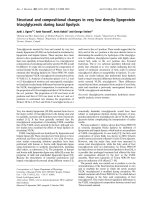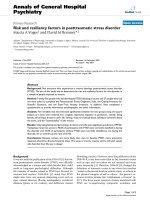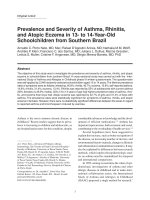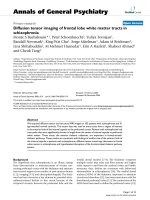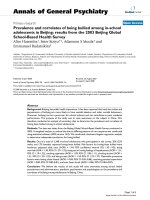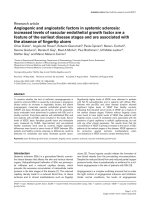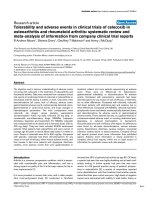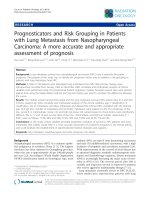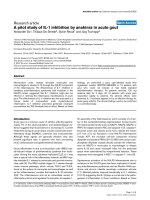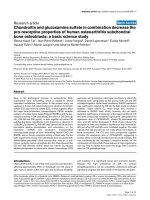Báo cáo y học: "Prevalence and Severity of Asthma, Rhinitis, and Atopic Eczema in 13- to 14-Year-Old Schoolchildren from Southern Brazil" potx
Bạn đang xem bản rút gọn của tài liệu. Xem và tải ngay bản đầy đủ của tài liệu tại đây (33.94 KB, 8 trang )
3
Asthma is the most common chronic disease in
childhood.
1
Recent studies suggest that its preva-
lence is incr
easing in c
hildr
en and adolescents,
as
ar
e hospitaliza
tion r
a
tes for this condition, despite
considerable advances in knowledge and the devel-
opment of efficient medications.
2–4
Asthma has
impor
tant r
e
per
cussions, both economic and social,
contr
ib
uting to the o
v
erloading of health services.
5,6
Se
veral hypotheses have been suggested to
e
xplain this increase, such as better recognition of
the disease
, an increasing number of doctors, and
environmental factors (namely,changes in lifestyle
and urbanization in industrialized countries). It may
also be explained by differences between research
methods, which implies that epidemiologic stud-
ies on asthma need be standardized for temporal
and international comparisons.
In 1992, aiming to maximize the value of epi-
demiologic investigations of asthma and other
allergic diseases in childhood and to make inter-
national collaboration easier, the International
Study of Asthma and Allergies in Childhood
(ISAAC) proposed a single method for research.
7
Original Article
Prevalence and Severity of Asthma, Rhinitis,
and Atopic Eczema in 13- to 14-Year-Old
Schoolchildren from Southern Brazil
Arnaldo C. Porto Neto, MD, Msc; Rafael D’Agostini Annes, MD; Nathalia M.M. Wolff,
Andréia P. Klein; Francisco C. dos Santos, MD; Juliana L. Dullius; Marina Gressler;
Letícia S. Muller; Cristine F. Angonese, MD; Sérgio Menna-Barreto, MD, PhD
Abstract
The objective of this study was to investigate the prevalence and severity of asthma, rhinitis, and atopic
eczema in schoolchildren from southern Brazil. A cross-sectional study was carried out with the Inter-
national Study of Asthma and Allergies in Childhood phase III written questionnaire. The questionnaire
was self-applied by 2,948 randomly selected schoolchildren aged 13 to 14 years.The lifetime prevalence
rates of symptoms were as follows: wheezing, 40.8%; rhinitis, 40.7%; eczema, 13.6%;self-reported asthma,
14.6%; rhinitis, 31.4%; eczema, 13.4%.Rhinitis was reported by 55% of adolescents with current asthma
(60% females vs 46.9% males). Girls 13 to 14 years of age had higher prevalence rates of asthma, rhini-
tis, and eczema than boys had. Atopic eczema was reported by 42.7% of girls and 31.4% of boys with
asthma. The prevalence rates were statistically significant for symptoms of asthma, rhinitis, and atopic
eczema in females. However, there were no statistically significant differences between the sexes in regard
to reported asthma and bronchospasm induced by exercise.
A.C. P
or
to Neto—Division of Pediatric Allergy-
Imm
unolo
g
y
,
São
Vicente de Paulo University Hospital –
F
aculty of Medicine
, University of Passo Fundo, Passo
Fundo, RS, Brazil; R. D’Agostini Annes, N.M.M. Wolff,
A.P
. Klein,
F
.C. dos Santos,
J
.L. Dullius,
M. Gressler, L.S.
Muller
,
C.F.Angonese—Faculty of Medicine, University
of P
asso Fundo,
P
asso Fundo,
RS
,
Br
azil; S
. Menna-
Bar
r
eto—F
aculty of Medicine
,
Federal University of Rio
Gr
ande do Sul; Pneumology Service, Hospital de Clínicas
de P
or
to
Ale
g
r
e
Cor
r
espondence to:
Dr
.
Ar
naldo C. P
or
to Neto,
Rua
Ga
br
iel Bastos 110,
P
asso Fundo,
RS – Brazil; E-mail:
por
DOI 10.2310/7480.2006.00001
4 Allergy, Asthma, and Clinical Immunology / Volume 2, Number 1, Spring 2006
Phase I of ISAAC showed that Brazil occupies
eighth place in prevalence, having a mean preva-
lence of 20% for current asthma. For ages 13 to 14
years, the prevalence rate varies from 4.8 to 27.1%.
8
The aim of this study was to investigate the
prevalence of asthma, rhinitis, and atopic eczema
and to investigate the relationship between rhini-
tis and eczema with severe asthma in school-aged
adolescents living in the city of Passo Fundo in
southern Brazil, an agricultural region, as part of
an ISAAC phase III project.
Materials and Methods
This study was carried out in Passo Fundo, a city
located in the state of Rio Grande do Sul (latitude
28°S and longitude 52°04´W), which shares bor-
ders with Uruguay and Argentina. The majority of
the population (88.8%) is Caucasian, descendants
of settlers from Portugal as well as immigrants
from Italy, Germany,and other European countries.
The total population consists of 182,233 inhabitants,
and the annual per capita gross product is approx-
imately $4,000 (US). The climate is temperate,
and the region has the characteristics of a humid
subtropical region with well-distributed rainfall.
The study was a cross-sectional survey of
schoolchildren aged 13 to 14 years. The students
were selected from children who attended the
public and private schools of Passo Fundo. Infor-
mation regarding the number of schools and stu-
dents was obtained from the records at the Sec-
retariat of Education. In the year 2002, 5,932
students in this age group were enrolled in pub-
lic and private schools, distributed among a total
of 80 schools. It was determined that schools with
50 or more enrolled students within this age group
would be assessed, according to the ISAAC pro-
tocol. A total of 46 such schools were identified.
From these, 26 schools were chosen by system-
atic randomized sampling, resulting in a sample
of 3,200 students.
Questionnaire
The instrument used in this study was the ISAAC
project pattern written questionnaire (WQ). In
Brazil, the questionnaires were translated into Por-
tuguese and validated.
9–11
The only alteration in the
questionnaire was a modification of the question
on seasonal rhinitis, formulated as “Have you ever
had allergic rhinitis,” instead of “Have you ever had
hay fever,” as in the original English version,
because the term “hay fever” as a synonym for sea-
sonal allergic rhinitis is little known in Brazil.
10
WQs were distributed in classrooms and filled
out by the adolescents under researchers’ super-
vision from May to September, 2002 (autumn and
winter). For absent students, another opportunity
was given at a later time. Every WQ that was cor-
rectly filled out was considered valid.
Ethical Approval and Consent
The study was approved by the Ethical Commit-
tee and Research of the Hospital das Clínicas de
Porto Alegre, Faculty of Medicine, Federal Uni-
versity of Rio Grande do Sul.
Permission for developing the survey in the
classrooms was given by the school principals, and
consent for participation was provided by parents
and by the adolescents themselves.
Statistical Analysis and Power Calculation
Collected data were entered into a database in
double-entry
EPI Info version 6.04, provided by
the ISAAC coordinators. Statistical analysis was
performed with
EPI Info version 6.04D. Non-
parametric tests (Pearson’s chi-square test was
used f
or tr
ends),
od
ds r
a
tio (OR),
and 95% con
-
f
idence inter
v
al (95% CI) w
er
e used to measur
e
the associa
tion f
or
ce among v
ar
ia
b
les,
and a
p
v
alue of < .05% w
as consider
ed to be signif
icant.
W
ith a sample of 3,000 subjects,
the po
w
er to
detect the dif
f
er
ence in the 1-y
ear pr
e
v
alence of
w
heezing and se
v
er
e asthma betw
een tw
o center
s
w
ould be 99% and 90%,
r
especti
v
el
y
, at the 1%
le
v
el of signif
icance
.
7
Definitions
In the present study, we defined subjects by the fol-
lowing criteria. Individuals were defined as having
had a severe attack of asthma if they answered
Asthma, Rhinitis and Atopic Eczema in Schoolchildren from Southern Brazil — Porto Neto et al 5
affirmatively to the question, “In the last 12 months,
has wheezing ever been severe enough to limit
your speech to only one or two words at a time
between breaths?” Individuals were defined as hav-
ing severe asthma if they answered affirmatively to
questions asking if they (1) had more than 12 attacks
of wheezing in the last year, (2) had disturbed sleep
due to w
heezing one or mor
e nights per w
eek, (3)
had w
heezing se
v
ere enough to limit their speech
to onl
y one or tw
o w
ords between breaths, and (4)
had w
heezing dur
ing or after e
xercise.
Results
T
he questionnair
es w
ere answered by students in
the c
lassr
oom,
and immediately returned. A total
of 3,161 questionnair
es w
er
e distributed. Of the
3,048 tha
t w
er
e returned, 2,948 (93.2%) were cor-
r
ectl
y f
illed out. Of the respondents, 51.3% were
f
emale and 48.7% w
er
e male; 55.5% were 13
y
ear
s of age and 44.5% were 14 years of age.
Tables 1 and 2 respectively show the preva-
lence and severity of asthma, rhinitis, and eczema.
The prevalence rate was significantly higher for
females than for males (
p < .05). “Ever wheezed”
and “ever had rhinitis” were the most common
affirmative responses, these symptoms respec-
tively having a lifetime prevalence of 43.6% and
47.1% in f
emales and 37.8% and 34.0% in males.
F
emales also r
esponded af
firmatively more
often than males to ha
ving had w
heezing in the pr
e-
vious 12 months,
noctur
nal coughing without r
es-
pir
a
tory infection, symptoms of rhinitis in the pre-
vious 12 months,
and symptoms of
rhinoconjuncti
vitis (
p < .001). F
emales also pr
e-
sented with mor
e a
ttacks of severe asthma than did
males (OR,
2.05; 95% CI,
1.40–2.99;
p < .001).
Re
g
arding the questions on “asthma diagnosed
b
y the doctor”
and “wheezing during or after exer-
cise
,
” there was no statistically significant differ-
ence betw
een the sexes. Symptoms of eczema
w
ere also more frequent among female adolescents
(
p < .001).
Affirmative and concomitant answers
Table 1 Self-Reported Prevalence of Asthma, Rhinitis, and Eczema and Their Related Symptoms
in 13- to 14-Y
ear-Old Schoolchildren
Gir
ls (%) Boys (%) All (%) OR
Symptom* (n = 1,513) (n = 1,435) (n = 2,948) (95% CI) p Value
Asthma
Ever wheezed 43.6 37.8 40.8
†
1.27 (1.09–1.48) < .01
Wheeze in the past year 23.1 17.7 20.5
†
1.40 (1.16–1.69) < .001
Wheezing with exercise last year 22.9 20.1 21.5 1.18 (0.98–1.41) > .05
Persistent cough last year 47.1 31.3 39.4
†
1.96 (1.68–2.29) < .001
Ever had asthma 13.5 15.7 14.60 0.83 (0.67–1.03) > .05
Rhinitis
Ever had rhinitis 47.1 34.0 40.7
†
1.72 (1.48–2.01) < .001
Rhinitis in the past year 35.2 23.6 29.5
†
1.76 (1.49–2.08) < .001
Associated itchy eye in 20.8 10.7 15.9
†
2.20 (1.78–2.74) < .001
the past year
Ever had allergic rhinitis 36.5 26.1 31.4
†
1.63 (1.39–1.92) < .001
Eczema
Chronic rash ever 15.7 11.4 13.6
†
1.44 (1.15–1.80) < .001
Chronic rash in the past year 10.5 6.7 8.6
†
1.64 (1.24–2.16) < .001
Chronic rash with 6.3 3.6 5
†
1.84 (1.28–2.65) < .001
typical distribution
Ever had eczema 15.3 11.4 13.4
†
1.40 (1.12–1.74) < .01
CI = confidence interval; n = population size; OR = odds ratio.
*From written questionnaire.
†
Indicates significance between girls and boys.
for asthma, rhinitis, and atopic eczema were given
by 2.1% of the adolescents. Approximately 55%
of the subjects with current asthma reported hav-
ing current rhinitis (64% females, compared to
36% males). Of the subjects who had current
asthma, 36% had associated allergic rhinocon-
junctivitis (68% females, compared to 32% males).
Approximately 10% of the subjects with current
asthma had atopic eczema (72% females, com-
pared to 28% males).
Symptoms of current rhinitis and atopic
eczema were significantly associated with symp-
toms of current asthma as well as with severe
attacks of asthma (OR for current asthma, 3.84;
95% CI, 2.67–5.52;
p < .0001) (OR for atopic
eczema, 4.0; 95% CI, 2.62–6.13;
p < .0001).
Discussion
In e
pidemiologic surveys that use WQs for obtain-
ing stud
y data, it is important to reach a total num-
ber of respondents that is close to the estimated
population because nonrespondents may generate
errors.
12
It is accepted that a rate of response of
about 90% is required to avoid such deviations in
data.
7
In this study, we observed a rate of about
93.2%, comparable to other studies in which the
ISAAC protocol was used.
In the present study, there was a predomi-
nance of symptoms of asthma, rhinitis, and atopic
eczema in girls. Recent studies indicate that the pre-
dominance observed for male preadolescents gen-
erally decreases at the end of adolescence,
13
result-
ing in an inversion of the proportions between
the sexes.
14,15
One possible explanation for this is
that boys in this age group might tend to under-
estimate their symptoms whereas girls in this age
group might tend to overestimate symptoms.
15
Anatomic
16
and hormonal factors characteristic
of puberty (especially the increase of estradiol
levels)
17
might also explain this change.
The number of wheezing attacks in the past
12 months is the most important item in defining
6 Allergy, Asthma, and Clinical Immunology / Volume 2, Number 1, Spring 2006
Table 2 Prevalence of Reported Symptoms Indicating Severity of Asthma, Rhinitis, and Eczema
Gir
ls (%) Boys (%) All (%)
Symptom (n = 1,513) (n = 1,435) (n = 2,948) p Value
Wheeze in past year
Number of w
heezing episodes
1–3 22.5* 16.8 19.7 < .01
4–12 1.3 1.7 1.5 > .05
> 12 0.1 0.6* 0.3 < .01
Awoken by wheeze
< 1 time each week 10.9 8.9 9.9
≥ 1 time each week 4.8* 2.6 3.8 < .01
Limitation of speech during wheezing 6.3 3.2 4.8 < .0001
Rhinitis in past year
Interference with daily activity
Little 18.2* 11.9 15.1 < .01
Moderate 3.8* 2.4 3.2 < .05
Severe 2* 0.8 1.4 < .01
Rashes in past year
Persistent rash without clearing 7.5* 4.8 6.2 .003
Kept awake by rash
< 1 time each week 3.4* 2.4 2.9 > .05
≥
1 time each week 1.9* 0.7 1.3 < .01
n = size of sample.
*Indicates significance between girls and boys.
cases of asthma because a characteristic of the
disease is repeated episodes of wheezing. Children
with four or more wheezing attacks in a year have
a greater probability of being asthmatic.
18
In our
study, the 12-month prevalence of wheezing (cur-
rent asthma) for these children was 20.5%. Approx-
imately 90% of the adolescents with symptoms of
current asthma reported one to three wheezing
attacks. One in 10 reported having four or more
wheezing attacks per year. One-fifth of those who
wheezed reported having had frequent sleep dis-
turbances one or more times per week. About one-
fourth of the adolescents who wheezed reported
having limitations of speech during wheezing
attacks. These results are similar to those observed
by Shamssain and Shamsian, in England.
19
Epidemiologic studies consistently show that
asthma and rhinitis are frequently associated in the
same patient.
20,21
For adolescents aged 13 to 14
years, the ISAAC protocol showed a 3.4% preva-
lence of association between asthma and allergic
rhinitis, with a variation of 0.5 to 40.0%.
22
In this
study, approximately 55% of the adolescents with
symptoms of current asthma had current rhinitis.
On the other hand, 36.9% of the subjects with
current asthma reported symptoms of rhinocon-
junctivitis. This is confirmation that asthma seems
to be more frequently associated with perennial
rhinitis than with seasonal rhinitis.
23
Of the ado-
lescents with current rhinitis plus current asthma,
75% had severe asthma (OR, 7.23; 95% CI,
1.78–34.09;
p = .0016),
indicating that among
asthma
tic patients, the presence of rhinitis is a
r
isk factor for severe asthma.
Atopic eczema predicts the development of
asthma and allergic rhinitis, being the “entrance
point” for subsequent allergic diseases.
24
Approx-
imately 80% of children with atopic eczema even-
tually may develop rhinitis or asthma, suggesting
a common systemic relation between respiratory
allergy and atopic eczema.
25
In this study, the data
show that 25% of the adolescents with atopic
eczema had more acute attacks of asthma (OR,
4.01; 95% CI, 2.62–6.13; relative risk [RR],
2.51–5.12;
p < .0001) than they had severe asthma
(OR, 3.55;
p = .078).
The association of asthma, rhinitis, and eczema
concomitantly is a reality. Austin and colleagues,
using the criteria of the ISAAC protocol in a study
involving 27,507 children aged 12 to 14 years, ver-
ified that 4% of the children reported associated
symptoms of asthma, rhinitis, and eczema.
26
Shamssain and Shamsian, assessing 3,000 ado-
lescents aged 13 to 14 years in Sunderland, Eng-
land, verified the concomitance of asthma, rhini-
tis, and eczema in 5.1% of subjects.
19
Data in the
present study showed that 2.1% of the adoles-
cents presented concomitantly with asthma, rhini-
tis, and eczema; these values were below those
found in the studies conducted in England. When
our data are compared with those of other centers
at a similar latitude in Latin America, it is observed
that there is a higher prevalence of asthma symp-
toms in Passo Fundo
27
(Table 3).
Regarding the limitations of the study, the
first is the fact that a self-reported questionnaire
may be subject to recall bias, and the study did not
include any objective tests such as bronchial hyper-
responsiveness (BHR) testing or exercise chal-
lenge. However, previous work showed that in an
English-speaking population, the ISAAC WQ has
reasonable sensitivity and specificity for BHR.
28
In Brazil, Camelo-Nunes and colleagues, by con-
structive validation of BHR by methacholine test-
ing, showed that the questionnaire option “wheez-
ing in the past 12 months” is the one that has the
best discriminatory power in the screening of asth-
matic and nonasthmatic patients.
29
A second limitation of this study was the
a
bsence of questions on possible risk factors such
as diet,
socioeconomic conditions,
8
f
amily his-
tor
y of atopy, passive or active smoking, the pres-
ence of pets, the mother’s education level, and
exposure to pesticides
30
and/or insecticides
31
(all
of which, being important for epidemiologic stud-
ies of asthma and allergic diseases, will be objects
of a subsequent study). In addition, using a ques-
tionnaire did not allow us to generate data on skin
test reactivity to inhalant allergens.
Conclusions
The prevalence rate of asthma in the study popu-
lation was close to the Brazilian mean but greater
than that of several centres in Latin America that
Asthma, Rhinitis and Atopic Eczema in Schoolchildren from Southern Brazil — Porto Neto et al 7
8 Allergy, Asthma, and Clinical Immunology / Volume 2, Number 1, Spring 2006
Table 3 Prevalence of Asthma Symptoms among 52,549 Children Aged 13 to 14 Years, from 17 Latin American Centres
Degrees WHEZEV WHEZ12 AWAKE12 SPEECH12 ASTHMAEV EXWHEZ12 COUGH12
Center Latitude N (%) (%) (%) (%) (%) (%) (%)
Cuernavaca 18°57´N 3,102 18.1 6.6 4.4 2.4 5.5 4.0 13.6
Costa Rica 9°56´N 3,200 37.6 23.7 15.2 10.1 18.5 24.2 31.1
David, Panamá 8°26´N 2,885 31.3 17.6 14.6 6.7 16.9 14.6 21.7
Recife 8°06´S 3,086 39.0 19.7 13.0 4.8 20.9 20.5 30.9
Lima 12°03´S 3,158 48.6 26.0 14.1 6.9 28.0 35.9 33.6
Salvador 12°58´S 3,162 44.3 27.0 9.6 5.4 12.5 27.6 29.6
São Paulo 23°32´S 3,007 45.4 23.3 12.0 2.7 10.0 20.5 33.0
Assunción 25°15´S 2,966 39.9 19.4 10.2 5.2 12.2 15.3 31.3
Curitiba 25°24´S 3,004 40.4 18.4 9.1 4.6 8.6 19.8 30.1
Porto Alegre 30°04´S 3,195 47.0 24.7 15.2 5.7 21.9 29.0 39.2
Rosario 33°00´S 3,008 23.9 11.8 7.6 4.4 7.9 16.5 41.9
South Santiago 33°27´S 3,051 27.8 11.1 7.0 4.9 11.5 25.3 32.8
Central Santiago 33.30´S 2,944 32.3 11.7 5.3 2.0 12.4 15.0 23.1
Buenos Aires 34°40´S 2,996 19.5 9.9 6.2 3.1 6.6 13.8 36.2
Montevideo 34°55´S 3,072 31.2 19.0 9.8 5.1 15.3 18.4 28.1
Valdivia 39°48´S 3,231 22.8 11.5 5.0 2.2 11.9 18.0 16.2
Puntas Arenas 53°09´S 3,482 21.9 6.8 3.9 1.3 7.3 6.3 15.5
—
52,549 33.6 16.9 9.5 4.5 13.4 19.1 28.6
P
asso Fundo
28
°
15´S 2,948 40.8 20.5 13.7 4.8 14.6 21.5 39.4
Ada
pted fr
om Mallol J et al.
27
ASTHMAEV = asthma e
v
er;
AWAKE12 = sleep disturbance from wheeze, 1 or more times a week in the last 12 months; COUGH12 = dry cough at night in the last 12 months;
EXWHEZ12 = wheeze with exercise in the last 12 months; N = size of population; SPEECH12 = wheeze severe enough to limit speech in the 12 months; WHEZEV = wheeze ever;
WHEZ12 = w
heeze in the last 12 months.
took part in the ISAAC project. Between the sexes,
there were no statistically significant differences
in regard to diagnosed asthma and exercise-induced
bronchospasm; however, there was a predomi-
nance of females over males in regard to other
symptoms of asthma, rhinitis, and atopic eczema.
It was also found that there was a strong associa-
tion between rhinitis and severe asthma in ado-
lescents; the same was true for atopic eczema and
severe attacks of asthma.
Future investigations are needed to confirm
these findings, as well as to investigate possible
etiologic factors.
Acknowledgements
We would like to thank the schools and the students
who participated. We would also like to thank Dr.
Dirceu Solé for his review and suggestions.
References
1. Myers TK. Pediatrics asthma epidemiology:
incidence, morbidity and mortality. Respir Care
Clin N Am 2000;6:1–14.
2. European Community Respiratory Health
Survey. Variations in the prevalence of respira-
tory symptoms, self reported asthma attacks,
and use of asthma medications in the European
Community Respiratory Health Survey
(ECRHS). Eur Respir J 1996;9:687–95.
3.
Bur
r ML,
Butland BK,
King S
,
Vaughan-
William E. Changes in asthma prevalence: two
surveys 15 years apart. Arch Dis Child
1989;64:1452–6.
4.
Ander
son HR. Incr
ease in hospital admission
for childhood asthma: trends in the referral,
severity, and readmissions from 1970 to 1985
in a health r
e
g
ion of United Kingdom.
T
horax
1989;44:614–9.
5. Toelle BG, Peat JK, Melis CM, Woolcock AJ.
The cost of childhood asthma to Australian
families. Pediatr Pulmonol 1987;19:330–5.
6. Solé D, Camelo-Nunes IC, Wandalsen GF, et
al. Is asthma in Brazilian children a public
health pr
ob
lem? Rev Bras Alergol Imunopatol
2004;27:185–8.
7. Asher MI, Keil U, Anderson HR, et al.
International Study of Asthma and Allergies in
Childhood (ISAAC): rationale and methods.
Eur Respir J 1995;8:483–91.
8.
Solé D, Yamada E, Vana AT, et al. International
Stud
y of Asthma and Allergies in Childhood
(ISAAC): prevalence of asthma-related symp-
toms among Brazilian schoolchildren. J
Investig Allergol Clin Immunol 2001;11:
123–8.
9. Vanna AT, Yamada E, Arruda LK, et al.
International Study of Asthma and Allergies in
Childhood: validation of rhinitis symptoms
questionnaire and prevalence of rhinitis in
schoolchildren in Sao Paulo, Brazil. Pediatr
Allergy Immunol 2001;12:95–101.
10. Solé D, Vanna AT, Yamada E, et al.
International Study of Asthma and Allergies in
childhood (ISAAC) written questionnaire: vali-
dation of the asthma component among
Brazilian children. J Investig Allergol Immunol
1998;8:376–82.
11. Yamada E, Vanna AT, Naspitz CK, Solé D.
International Study of Asthma and Allergies in
Childhood (ISAAC)—validation of the written
questionnaire (eczema component) and preva-
lence of atopic eczema among Brazilian chil-
dren. J Investig Allergol Immunol
2002;12:34–41.
12. Papageorgiou N, Gaga M, Avarlis P, et al.
Responses rates influence the estimation of
prevalence rates of asthma and asthma-like
symptoms. Eur Respir J 1995;8:53s.
13.
P
earce N, Weiland S, Keil U, et al. Self-reported
prevalence of asthma symptoms in children in
Australia, England, Germany and New
Zealand: an international comparison using the
ISAAC protocol. Eur Respir J 1993;6:1455–61.
14.
Sennhauser FH,
Kühni CE. Pr
e
v
alence of res-
pir
a
tory symptoms in Swiss children: is
bronchial asthma really more prevalent in
boys? Pediatr Pulmonol 1995;19:161–6.
15. Venn A, Lewis S, Cooper M, et al.
Questionnair
e stud
y of ef
f
ect of se
x and a
ge on
the pr
e
valence of wheeze and asthma in adoles-
cence. BMJ 1998;316:1945–6.
16. Tepper RS, Morgan WJ, Cota K, et al.
Physiological growth and development of lung
dur
ing the f
ir
st y
ear of life. Am Rev Respir Dis
1986;134:513–9.
Asthma, Rhinitis and Atopic Eczema in Schoolchildren from Southern Brazil —
Porto Neto et al 9
17. Troisi RJ, Speizer FE, Willett WC, et al.
Menopause
, postmenopausal estrogen prepara-
tion and the risk of adult-onset asthma. A
pr
ospective cohort study. Am J Respir Crit Care
Med 1995;152:1183–8.
18.
Reisman JJ, Canny GR, Levison H. Wheezing
in infants and young children. In: Tinkelman
DG, Naspitz CK, editors. Childhood asthma.
New York: Marcel Dekker; 1993. p. 255–82.
19. Shamssain MH, Shamsian N. Prevalence and
severity of asthma of asthma, rhinitis, and
atopic eczema in 13 to 14 year old schoolchild-
ren from the northeast of England. Ann Allergy
Asthma Immunol 2001;86:428–32.
20. Yawn BP, Yunginger JW, Wollan PC, et al.
Allergic rhinitis in Rochester, Minnesota, resi-
dents with asthma:
frequency and impact on
health care charges. J Allergy Clin Immunol
1999;103:54–9.
21. Greisner WR, Settipane RJ, Settipane GA. Co-
existence of asthma and allergic rhinitis: a 23-
year follow-up study of college students.
Allergy Asthma Proc 1998;19:185–8.
22. Worldwide variation in prevalence of symptoms
of asthma, allergic rhinoconjunctivitis, and
atopic eczema: ISAAC. The International Study
of Asthma and Allergies in Childhood (ISAAC)
Steering Committee. Lancet 1998;351:
1225–32.
23. Leynaert B, Bousquet J, Neukirch C, et al.
Perennial rhinitis: an independent risk factor
for asthma in nonatopic subjects: results from
the European Comm
unity Respiratory Health
Survey. J Allergy Clin Immunol 1999;
104:301–4.
24. Beck LA, Leung DY. Allergen sensitization
through the skin induces systemic allergic
responses. J Allergy Clin Immunol 2000;106
Suppl 5:S258–63.
25. Leung DYM. Atopic dermatitis: new insights
and opportunities for therapeutic intervention. J
Allergy Immunol 2000;105:860–76.
26. Austin JB, Kaur B, Anderson HR, et al. Hay
fever, eczema and wheeze: a nationwide UK
study. Arch Dis Child 1999;81:225–30.
27. Mallol J, Solé D, Asher I, et al. Prevalence of
asthma symptoms in Latin America: the
International Study of Asthma and Allergies in
Childhood (ISAAC). Pediatr Pulmonol
2000;30:439–44.
28. Shaw R, Woodman K, Ayson M, et al.
Measuring the prevalence of bronchial hyperre-
sponsiveness in children. Int J Epidemiol
1995;24:597–602.
29. Camelo-Nunes I, Wandalsen GF, Melo KC, et
al. Prevalence of asthma and related symptoms
among schoolchildren living in Sao Paulo,
Brazil: from 1996 to 1999—study of bronchial
responsiveness among adolescents with active
asthma and non-asthmatic adolescents—
“ International Study of Asthma and Allergies
in Childhood (ISAAC).” Rev Bras Alergol
Imunopatol 2001;24:77–89.
30. Salome CM, Marks GB, Savides P, et al. The
effect of insecticide aerosols on lung function,
airway responsiveness and symptoms in asth-
matic subjects. Eur Respir J 2000;16:38–43.
31. Salameh PR, Baldi I, Brochard P, et al.
Respiratory symptoms in children and exposure
to pesticides. Eur Respir J 2003;22:507–12.
10
Allergy, Asthma, and Clinical Immunology / Volume 2, Number 1, Spring 2006
